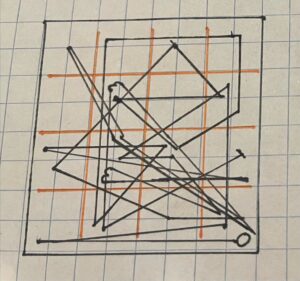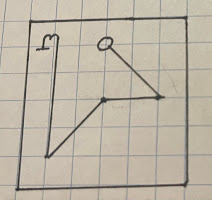In the world of magic, there are fewer things more divisive it seems than the ideas around invocation/evocation of spirits and what it means to interact with them. This isn’t a matter of any small or trivial difficulty, even for those who have experienced such phenomena themselves. The difficulty is even greater for those who have not achieved such communication, and who are often left wondering what exactly they should expect or how things are supposed to work. As with many things in magic, nothing is going to look exactly the same from one practitioner to the next, and our current subject is no different. While I can only provide my own perspective on the issue, I am doing so in the hopes that it can clear a bit of the confusion around the topic and bring practitioners (and aspiring practitioners!) together with some more productive dialogue.
Much of the perplexity seems to surround exactly what should be expected in terms of the encounter with the spirits. Joseph Lisiewski famously put forward the idea that evoked spirits must be conjured to physical manifestation, which has probably done more to provoke doubt and contribute to imposter syndrome among magicians who work with such spirits than any other statement in the past century.
The simple fact is, the vast majority of people who work with spirits, no matter how intimately, do not experience them as physical manifestations. Much like the person who looks into magic expecting to figure out how to teleport and hurl fireballs, one who begins working with spirits anticipating that they will appear in a grandiose poof! of smoke and celestial light will very quickly find themselves disappointed.
And this, dear reader, is why I am writing today: to help dispel some of those faulty beliefs and expectations that we all inherit over the course of our lives, and to encourage you to live the magical life you want to be living.
My Backstory
For a long time I thought that I was a “squib”, incapable of scrying with any meaningful success. Like John Dee, I could be the magical operator in such a working, but felt that in order to make any progress with spirit work I would need to find a talented scryer to work with if I were to see any results from it. Then I had some encounters that were too intense to ignore–and it not only gave me a new understanding of what it meant to converse with spirits, but also showed me that many of my previous assumptions about the nature of that conversation were utterly incorrect. Moreover, I came to recognize that I had already been experiencing the spirits, but had failed to recognize it at the time because of my self-imposed conceptual blinders.
The greatest irony of all is that it was precisely such an experience, back when I was 12 years old, that ultimately led me to the path I walk today. The way that I have described the experience ever since is that it was like being hit upside the head with a brick wrapped in velvet. I experienced a thought in my head that not only was not my own, but came into my head all at once, fully formed, rather than word by word as my own thoughts are generally produced. To quote Philip K. Dick, speaking of his own life-changing experience, it was as if “my mind was invaded by a transcendentally rational mind”. The message brought peace and clarity in a moment when I felt in crisis. Not only was the thought not my own; but whatever its source, it seemed to be benevolent and caring. At the time I believed it was the voice of God that I was hearing. My desire to understand what happened to me, and even more so my desire to achieve that communication again, led me to make a lifelong study of religion and mysticism, and to tread down the magical path as soon as I discovered that it existed.
You might think that having had that encounter once I would experience it again in short order, but I didn’t. Not until twenty-seven years had passed, more than 25 of which were spent in the pursuit of magic. But I don’t claim that my results are typical. I had to spend a long time wandering in the dark before I realized that a lot of my benightedness was self-inflicted. And that didn’t happen for me until I had another encounter–one that felt less like a velvet-wrapped brick and more like a nuclear warhead.
I never said that I was the most perceptive person, and apparently it takes rather a lot to get my attention. Oops.
Over the past several years, I’ve had a number of very successful scrying sessions, as well as some more spontaneous contacts with the gods and spirits–which leads me to believe that my previous issues were less to do with my own innate capabilities (or lack thereof), and more to do with faulty beliefs and expectations leading me not to try my hand at actually doing the thing and being persistent at it.
It was only after my nuclear wake-up call (and an embarrassingly long amount of time after that, I might add) that I started to realize I did have spirit contact before that. I just didn’t recognize it, because I didn’t understand that those interactions generally happen inside your own head and can sometimes feel more like a part of you than something external. Of course, at the time I was still working within the confines of the Golden Dawn system, which intrinsically puts the magical contact on rails in order to make it safer by confining it to a specific form in order to introduce budding magicians more gradually to the things they will experience once they step out on their own as Adepts and begin to do more advanced workings solo. But I did notice that, especially after my Adeptus Minor initiation, things started to feel different. When I was assuming the godform of a temple office, I would connect with it emotively in ways that felt new and curious to me. I allowed the feelings to guide my voice, informing the tones and facial expressions and other mannerisms that I adopted in speaking my ritual parts. It just felt right. And while I heard no voices and saw no visions during those times, I’ve come to recognize since that those connections I had with the godforms were real contacts. I simply didn’t realize it at the time, because I’m so used to verbal communication that it didn’t occur to me that spirit communication can also be emotive and nonverbal. And the middle of a scripted ceremony isn’t an especially inviting context in which to have a two-way conversation. Gotta read those lines, after all, and the ritual isn’t any more conducive to communication between a magician and a spirit than it is to side-chatter between the various ritual participants.
So while much is made of visions and voices, there’s more to it than just that. Communication can very easily (perhaps more easily) be emotive or otherwise nonverbal as well. But what of the visions and the voices?
Spirit Communication: How It Works for Me
As I’ve already recounted, one way that spirits can communicate is emotively: via emotional impressions directly upon the psyche. We can call this clairsentience, or the ability to feel that communication on an emotive or affective level.
Generally speaking, however, I experience the spirits in visions and/or voices. As with emotive communication, one of the greatest points of confusion is that those who have written about such experiences have not been especially detailed about what this experience is actually like. Consequently, people who are new to spirit conjure may assume that a spirit will appear to the physical apparatus of their eyes, like a concrete object. Or they may assume that the voice of a spirit will sound much like the voice of another person in the room with them. This may happen in some instances for some people, but it has not been my experience; nor have I encountered any other spirit workers describing it as theirs to the best of my recollection.
We may term the seeing of visions clairvoyance if we so choose. The distinction between a daydream and a vision is a fine one when describing the difference in how the two work; but when I experience a vision, I generally find that I am not the one in the driver’s seat. Instead I’m viewing a tableau unfolding in my head, consistent with the nature of the spirit that I am conjuring. Sometimes it is a static image, sometimes it is a moving one; but when the image moves, it does so of its own accord–not mine. I am cognizant of what I am seeing, I can shift my focus from one portion of the image to another, but the way it unfolds is much like a (non-lucid) dream in that I appear to have little conscious agency in the process.
Similarly for voices. When I hear the voice of a spirit, it takes place entirely within my head. We can call this clairaudience. Studies have shown that there are some people who don’t have internal monologues, but I am not one of them. My internal monologue is constant. As a result, I have a pretty good handle on what “my” internal voice sounds like, in the same way that other people can recognize me by the sound of my voice. When I have the voice of a spirit inside my head, however, it is not that same voice. It “sounds” different, for lack of a better word. Additionally, those messages generally tend to enter my head fully-formed, whereas my internal monologue is created word by word as I think to myself in phrases and sentences. To borrow a term from computer science, my internal monologue is processed in serial, one word or piece of data after another; whereas the voices of the spirits almost always come to me in a manner that feels more parallel, in which the various words are transmitted all at once and are received at the same time.
When I have had two-way communication with spirits, they also seem to be able to receive my thoughts telepathically in the same way that they transmit their own. In one notable encounter with the archangel Cassiel, he answered a question that I had barely begun to formulate in my head, much less “voiced” to him. Some spirit workers insist that spirits only respond to verbal communication, believing that it draws firmer boundaries if one chooses to speak messages aloud rather than doing so in one’s head. There is certainly something disconcerting about having another entity inside your head; but whereas the explanation I heard for this choice was that spoken communication doesn’t allow for a spirit to “get inside your head”, I for one am unconvinced that it makes any practical difference whether one chooses to communicate verbally or telepathically with the spirits. In any case, if you are working with an entity you do not wish to communicate as intimately with, you should have all of the requisite protections of a circle and a magical weapon and names of power at your disposal: this should provide sufficient protection for the operator regardless of how the operator chooses to communicate from their own end, and will generally make little difference as to how the communication from the spirit itself comes across.
One thing I have noticed about both visions and voices in spirit communication is that if you poke at the message (whether the vision you are seeing or the message that the voice has spoken), it will demonstrate resiliency. That is to say, when I am engaging in my own internal monologue, I can choose to derail that monologue in any number of different directions whenever I want. When I receive a vision or a message, however, and look askance at it in my head and start questioning it, I will feel a push back in my direction, reasserting the original content. This is much like pushing at a flexible membrane, feeling the equal and opposite pressure against your finger, and seeing the membrane spring back to its original form when you withdraw. This usually feels very gentle, but definite. During one encounter I was receiving a message which I understood was to be delivered to another person. I recall being surprised by the wording of the message, and thought to myself, “maybe I should soften that a bit.” To my surprise, the spirit gently poked me in the forehead with her finger as if to say “nope!” and I felt the words come again the same as before. While the pushback isn’t generally quite that tactile in my experience, it is nonetheless a commonality.
These properties of spirit communication are very jarring at first, but I quickly grew accustomed to them–and to recognizing them as signs of a potential spirit contact, as opposed to a mere misfire of the brain.
Finally, you’ll notice I didn’t title this section “Spirit Communication: How It Works”. I’ve spoken with enough other spirit conjurers, read enough works by them, and have listened to enough interviews with them, that I believe my experience of spirit communication is fairly typical. That doesn’t mean others don’t experience them differently, or that my experience is somehow
normative. Moreover, atypical is not synonymous with incorrect. Polyphanes has
written before about his experiences coming predominately in taste and smell (
clairgustance and
clairalience, respectively) whereas he experiences little in the way of vision. It may not be the most common method of experiencing, but it’s pretty damn cool nonetheless, and I don’t doubt his results as a magician.
A Final Note
If you haven’t yet read Polyphanes’ post “
Beginner’s Practices” (also linked above), I strongly suggest you hasten to read it. He echoes much of what I have said here, while providing some truly sage advice for people starting out–especially those who are trying to work with spirits.
Additionally, please note that just because an entity is discarnate and capable of communicating with you telepathically, that does not mean you should implicitly trust any information or advice that you may be given. Always verify any information given, and always test the spirits. By their fruits ye shall know them.
—
(This post was prompted by a conversation I had with my friend “linceoui” whom I know from the Hermetic Agora Discord server–which you should check out if you haven’t already! Shout-out to you, and thanks for always giving me good conversations and a lot to think about.)




